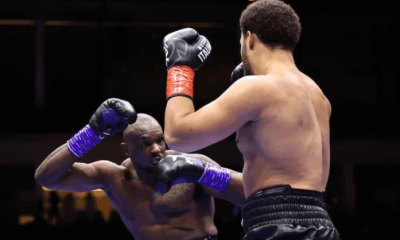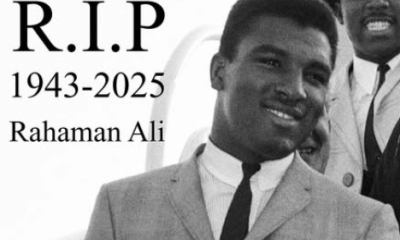Articles of 2006
Harry Haft, Auschwitz, and Rocky Marciano
Rarely have firsthand accounts of the horrors of the Holocaust been more vividly described than they are in a compelling new book called “Harry Haft: Survivor of Auschwitz, Challenger of Rocky Marciano,” which will be released by the Syracuse University Press on May 30.
Haft, who is one of only a handful of surviving Marciano opponents, squared off against the future heavyweight champion, who was 17-0, in the ten-round main event at the Rhode Island Auditorium in Providence in July 1949. A crowd of 1,655 fans were in attendance.
In what would be the final fight of a pro career that began just 11 months earlier, Haft weighed in at 174, while Marciano tipped the scales at 184 ½.
While in training camp, Haft, who knew a loss to Marciano would probably signal the end of his career, allowed himself to be hypnotized. He had hoped it would give him an advantage against Marciano, who was rampaging through opponents with unbridled ferocity.
While warming up in his dressing room, Haft says three men entered and threatened to kill him if he did not go down in round one. When they left, Haft asked his manager what he should do. The manager just shrugged his shoulders and said he didn’t know.
Having already survived Nazi death camps, the undeterred Haft refused to go along. An article in the Providence Journal described him as “a rusher with very little style,” and said that he “landed the first good punch of the fight, a hard right to Marciano’s midsection.”
Marciano hurt Haft in the second with a right hand that sent him reeling into the ropes. Two follow-up lefts had Haft groggy at the bell.
“Two hard punches to Haft’s head—a left and a right—were Marciano’s openers in the third,” reported John Hanlon in the Journal. “At the halfway mark, Haft rallied briefly. But it was too late.”
Marciano hit Haft with a left to the gut that he followed up with his fabled right hand. Haft was finished. According to the Journal, he “received a fine reception as he left the ring.”
The strapping and robust Haft, who in his previous fight had been stopped in four rounds by Roland LaStarza, retired with a record of 13-7 (7 KOS). Now 81, he lives in Florida.
The author, Alan Scott Haft, compellingly writes about his father’s career as a professional boxer. But that all pales in comparison to his dad’s experiences in various Nazi slave labor and concentration camps during World War II.
Harry Haft was born in Poland in 1925. “It was anything but good fortune to be born a Jew in Poland in 1925,” writes his son. “Harry would think back on his birth as his first act of survival in an increasingly miserable time.”
One of eight children, Haft was sturdy and strong from the get-go. His first act of survival was remaining unscathed at the time of his birth. His mother, who was so heavy she did not even know she was pregnant with him, was working over a basin when he dropped from her and landed headfirst on the floor.
Haft always had a fiery temper, which was displayed most often against anti-Semitic youths, as well as during soccer games. From an early age, he made clear that if he was provoked he had no qualms about taking care of business with his fists.
During the German occupation of Poland in 1939, Haft was captured by the Nazis when he went looking for his brother, who had already been rounded up. He left behind his girlfriend, Leah, who later played a major role in why he chose to become a professional boxer.
Because of Haft’s brute strength, street savvy, and his relationship with a somewhat sympathetic guard, he was able to get work assignments where he could steal food. However, the relationship with the guard came with a big price tag when he volunteered Haft to become a fighter.
Every Sunday Haft would square off in bare-knuckle brawls against other detainees for the perverse pleasure of the SS guards. The battles were literally fights to the finish because the losers would be hauled off and executed.
Because Haft never once lost a fight, his German tormentors began referring to him as the “Jew Animal.” Described as a “flat-footed, toe-to-toe puncher,” he even beat a slick moving Frenchman who was imported by the Nazis to test his mettle like it had never been tested before.
After toppling the Frenchman like a giant tree, Haft saw him being dragged out of the ring. Although the Frenchman had been a favorite fighter of the Germans, he was never seen or heard from again.
After witnessing countless acts of horrific sadism, Haft managed to make his escape. He stole the uniform and weapon of a German soldier whom he had killed with his bare hands. He then tried to pass himself off as a lost soldier to several elderly German citizens whom he encountered at their farmhouses.
When they suspected—or he even thought they suspected—that he might not be who he said he was, he feared that they would turn him into authorities. Knowing he would be tortured or killed if that occurred, Alan Haft unabashedly describes his father shooting them with nary a second thought.
Eventually Haft came in contact with American liberators. While living in a displaced person’s camp, he won the Jewish Boxing Championship. In doing so, he was presented with a statue of Apollo.
After journeying to America, Haft began boxing out of desperation. But that was not the only reason. He hoped that he would attain enough notoriety for his lost love, Leah, to hear of him and locate him.
At the time he had no idea if either she or her family had survived the camps.
It would be decades until he learned of her fate. One of the most powerful passages in the book is when he finally does.
You do not have to be a boxing fan to be affected by this book. It is about how one man—stripped to his primal core—was able to survive unspeakable inhumanities and indignities on nothing more than his instinct and resolve.
While boxing in America, Haft encountered even more problems, especially when gangsters Frankie Carbo and Blinky Palermo tried to take control of his career.
While the book has some flaws, such as minimal detail on what kind of husband and father Haft was, it is an invaluable contribution to Holocaust and boxing literature.
In one of the informative forewords, John Radzilowski describes Jewish life in Poland in the years leading up and during the war.
The other foreword, by noted boxing historian Mike Silver, describes Haft’s career in the late forties, when Jewish fighters were still not all that uncommon.
“Harry Haft” was published by the Syracuse University Press. It can be purchased in bookstores, as well as on-line through Amazon.com or BarnesandNoble.com.
For further information, log onto the Syracuse University Press at: SyracuseUniversityPress.syr.edu.
-

 Featured Articles4 weeks ago
Featured Articles4 weeks agoThe Hauser Report: Zayas-Garcia, Pacquiao, Usyk, and the NYSAC
-

 Featured Articles3 weeks ago
Featured Articles3 weeks agoOscar Duarte and Regis Prograis Prevail on an Action-Packed Fight Card in Chicago
-

 Featured Articles2 weeks ago
Featured Articles2 weeks agoThe Hauser Report: Cinematic and Literary Notes
-

 Book Review2 weeks ago
Book Review2 weeks agoMark Kriegel’s New Book About Mike Tyson is a Must-Read
-

 Featured Articles4 weeks ago
Featured Articles4 weeks agoRemembering Dwight Muhammad Qawi (1953-2025) and his Triumphant Return to Prison
-

 Featured Articles7 days ago
Featured Articles7 days agoMoses Itauma Continues his Rapid Rise; Steamrolls Dillian Whyte in Riyadh
-

 Featured Articles3 weeks ago
Featured Articles3 weeks agoRahaman Ali (1943-2025)
-

 Featured Articles3 weeks ago
Featured Articles3 weeks agoTop Rank Boxing is in Limbo, but that Hasn’t Benched Robert Garcia’s Up-and-Comers














